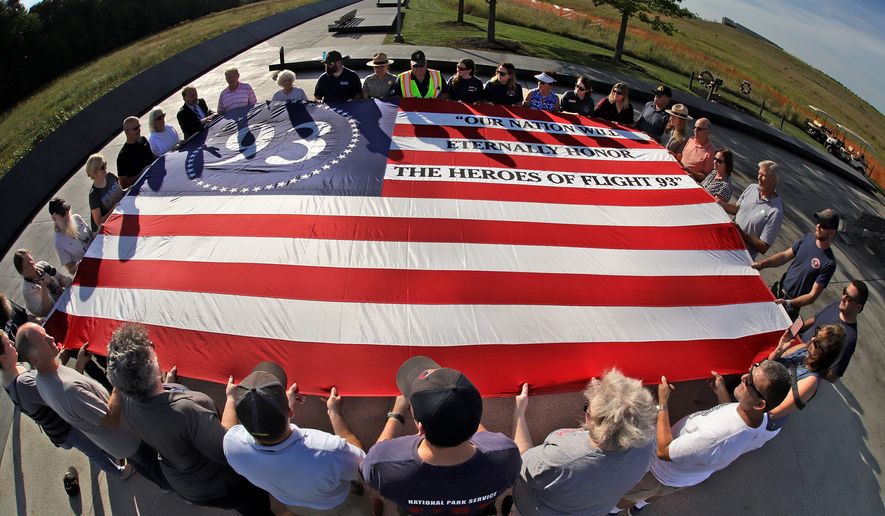Buses carrying schoolchildren still travel to a Pennsylvania field where a Boeing 757 crashed 18 years ago.
But unlike the first groups of children who made the journey — many having watched the 9/11 attacks unfold on TV — today’s students had not yet been born when the U.S. pivoted into a war, color-coded terrorism warnings, and nationwide mourning and remembrance.
“Certainly young children and those who were not yet born when the events of Sept. 11, 2001, took place will view this place differently,” said Beth Parnicza, acting public information officer for the Flight 93 National Memorial outside of Shanksville, Pennsylvania. “[But] schools are still visiting the memorial, and the park is committed to engaging students and visitors of all ages.”
Nearly two decades since terrorist attacks rocked a nation and the words “never forget” became a national mantra, the duty of memorializing the day falls to a new generation.
Since the 2011 opening of the memorial in Manhattan, more than 48 million visitors have paid their respects at two reflecting pools, the site of the collapse of the World Trade Center after two terrorist-hijacked airliners slammed into the twin towers. However, more than half of those visitors, 32 million, arrived within the first four years of the opening.
Lesson plans for teachers preparing their students for visits to the National September 11 Memorial & Museum in New York explore the day’s events, its repercussions and first responders.
Kindergartners to second-graders are asked, “What do you wonder about the towers?” They are told about French artist Philippe Petit, who walked on a high wire between the twin towers in 1974.
High school lesson plans ask students to explore Afghan literature and engage in discussions about airport security versus civil liberties.
Across the Potomac River from Washington, where 184 were killed when a jetliner struck the west side of the Department of Defense headquarters, the benches of the National 9/11 Pentagon Memorial will close Sept. 16 to begin repairs to the site. The gateway to the memorial will close from Nov. 16 until next year.
“We are aware of the impact that this closure will have on family members and visitors to the Pentagon Memorial,” officials said in the release. “Every effort has been made to develop a construction plan that will enable the work to be completed in a quick and efficient manner, reducing site closure time.”
The repairs will address water damage and the electrical system, including lights for the benches.
Congress and President Trump in July approved the extension of the James Zadroga compensation fund, which pays for the treatment of illnesses suffered by the first responders and survivors of the attacks.
Many rescue and recovery workers developed latent respiratory and digestive ailments linked to toxic dust at ground zero. Other illnesses, including cancer, have been diagnosed.
Michael Barasch, a New York injury lawyer who has represented thousands of 9/11 victims, told The Washington Times last week that the rates of cancers and other health issues linked to the toxic dust is “astronomical and frightening.”
According to the World Trade Center health program, more than 2,300 cancer deaths have been linked to 9/11 toxins. More than 10,000 people also have developed cancer from the aftermath of the terrorist attacks.
All in all, Mr. Barasch said, an estimated 400,000 people were affected by 9/11.
“Survivors are the forgotten victims,” he said.
Research continues into whether those illnesses are tied to 9/11 toxins. A 2018 study did not find higher than normal death rates overall among people exposed to the dust and smoke, but researchers have noted more deaths than expected from brain cancer, non-Hodgkin lymphoma and certain other diseases. The number of suicides among rescue and recovery workers also is unusual.
Studies have suggested that highly exposed workers may face more problems, including somewhat higher death rates and a modestly higher risk of heart trouble, than less-exposed colleagues.
More than 51,000 people have applied to a victims compensation fund that makes payments to people with illnesses potentially related to 9/11. The fund has awarded over $5.5 billion so far. There also is a push to configure names of first responders victimized by the thick clouds of smoke and fires that burned for months in the rubble.
With growing attention to the deaths of ailing 9/11 rescue, recovery and cleanup workers, some memorials elsewhere began adding their names, The Associated Press reported. A remembrance wall to them was dedicated in 2011 in Nesconset, New York.
But the trade center memorial has a “responsibility — especially where it’s located, on sacred ground — to continue to tell the story,” said John Feal, who lost part of a foot while working as a demolition supervisor there and later founded a charity that maintains the Nesconset memorial, the AP reported.
In addition to the names of nearly 3,000 Sept. 11 victims, a half dozen stacks of stone will quietly salute an untold number of people who aren’t on the list.
The granite slabs were installed on the memorial plaza this spring. They recognize firefighters, police and others who died or fell ill after exposure to toxins unleashed in the wreckage. Officials say names will be added as the aftermath of 9/11 continues to evolve, the AP reported.
⦁ Shen Wu Tan contributed to this article, which is based in part on wire service reports.
• Christopher Vondracek can be reached at cvondracek@washingtontimes.com.




Please read our comment policy before commenting.